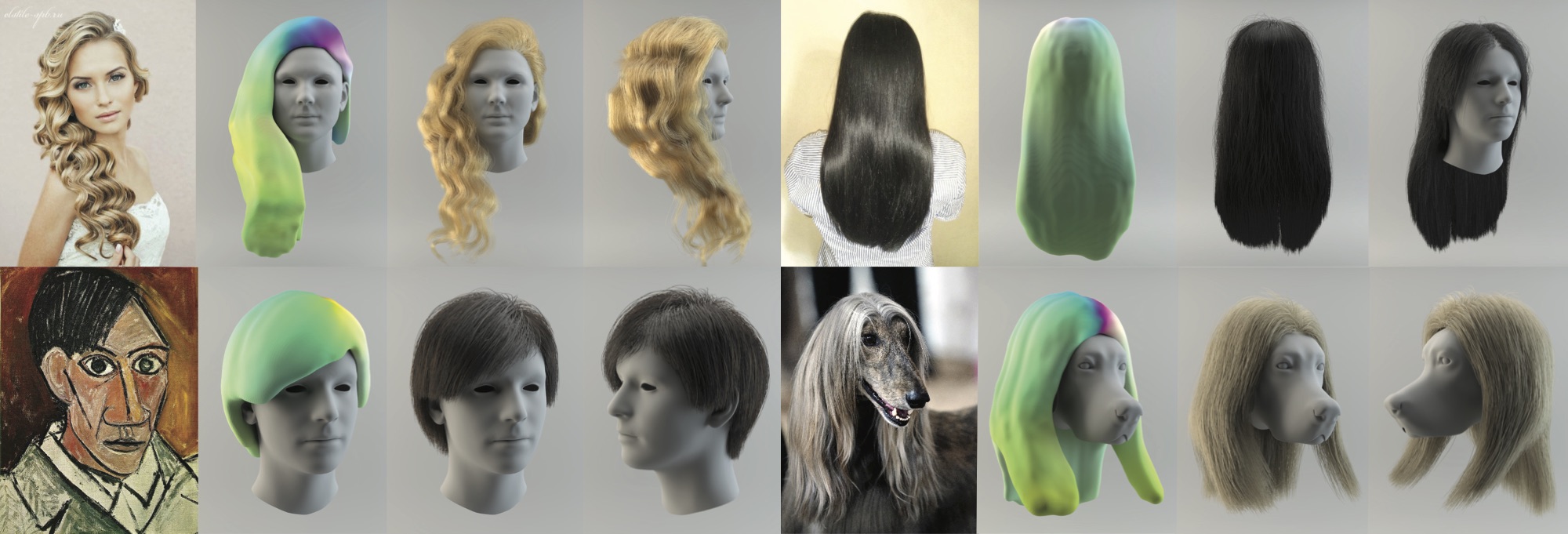3D Hair Synthesis Using Volumetric Variational Autoencoders
- Shunsuke Saito1,2,3
- Liwen Hu1,2
- Chongyang Ma4
- Hikaru Ibayashi2
- Linjie Luo4
- Hao Li1,2,3
- 1Pinscreen
- 2University of Southern California
- 3USC Institute for Creative Technologies
- 4Snap Inc.

Our method automatically generates 3D hair strands from a variety of single-view inputs. Each panel from left to right: input image, volumetric representation with color-coded local orientations predicted by our method, and final synthesized hair strands rendered from two viewing points.
Abstract
Recent advances in single-view 3D hair digitization have made the creation of high-quality CG characters scalable and accessible to end-users, enabling new forms of personalized VR and gaming experiences. To handle the complexity and variety of hair structures, most cutting-edge techniques rely on the successful retrieval of a particular hair model from a comprehensive hair database. Not only are the aforementioned data-driven methods storage intensive, but they are also prone to failure for highly unconstrained input images, complicated hairstyles, and failed face detection. Instead of using a large collection of 3D hair models directly, we propose to represent the manifold of 3D hairstyles implicitly through a compact latent space of a volumetric variational autoencoder (VAE). This deep neural network is trained with volumetric orientation field representations of 3D hair models and can synthesize new hairstyles from a compressed code. To enable end-to-end 3D hair inference, we train an additional embedding network to predict the code in the VAE latent space from any input image. Strand-level hairstyles can then be generated from the predicted volumetric representation. Our fully automatic framework does not require any ad-hoc face fitting, intermediate classification and segmentation, or hairstyle database retrieval. Our hair synthesis approach is significantly more robust and can handle a much wider variation of hairstyles than state-of-the-art data-driven hair modeling techniques with challenging inputs, including photos that are low-resolution, overexposured, or contain extreme head poses. The storage requirements are minimal and a 3D hair model can be produced from an image in a second. Our evaluations also show that successful reconstructions are possible from highly stylized cartoon images, non-human subjects, and pictures taken from behind a person. Our approach is particularly well suited for continuous and plausible hair interpolation between very different hairstyles.
Keywords
hair synthesis, single-view modeling, deep generative model, volumetric variational autoencoder
Paper

Links
- [ Paper 74MB (Low-res version 7MB) ]
- [ Video 165MB Youtube ]
- [ BibTex ]